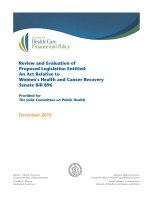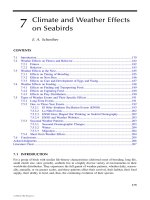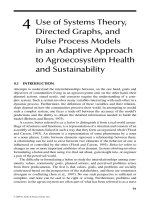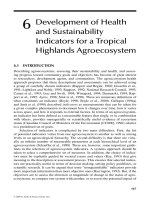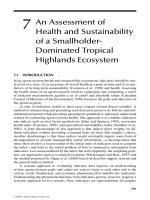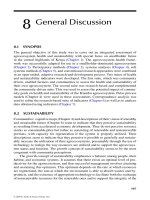Integrated Assessment of Health and Sustainability of Agroecosystems - Chapter 7 pdf
Bạn đang xem bản rút gọn của tài liệu. Xem và tải ngay bản đầy đủ của tài liệu tại đây (441.47 KB, 16 trang )
181
7
An Assessment of
Health and Sustainability
of a Smallholder-
Dominated Tropical
Highlands Ecosystem
7.1 INTRODUCTION
In an agroecosystem health and sustainability assessment, indicators should be ana-
lyzed in two ways: (1) as measures of overall health at a point in time and (2) as pre-
dictors of its long-term sustainability (Costanza et al., 1998) and health. Assessing
the health status of an agroecosystem involves comparing and contrasting a series
of indicator measurements against a set of cutoff and threshold values (Canadian
Council of Ministers of the Environment, 1996) based on the goals and objectives of
the agroecosystem.
A suite of indicators would in most cases contain several dozen variables. A
method of summarizing and presenting such data must preserve its holistic and mul-
tidimensional nature while providing meaningful, quantitative, and easily understood
criteria for evaluating agroecosystem health. One approach is to combine indicators
into indices such as total factor productivity (Ehui and Spencer, 1993), ecosystem
health index (Costanza, 1992), and agricultural sustainability index (Nambiar et al.,
2001). A fatal disadvantage of this approach is that indices place weights on dif-
ferent indicators without providing a rational basis for their (the weights’) choice.
Another disadvantage is that these indices would eventually require some form of
decomposition to provide managerially useful information—a decomposition that
more often involves a reassessment of the initial suite of indicators used to compute
the index—and back to the initial problem of how to summarize information from
indicators. Less unencumbered by the latter, but still crippled by the weighting prob-
lem, are approaches such as ecological footprint (Wackernagel and Rees, 1997) and
the method proposed by Afgan et al. (2000) based on decision support systems and
the general indices method.
A systems approach to evaluating indicator data requires an understanding
of how agroecosystem goals and values are seen to relate to each other and to the
various social, biophysical, and economic phenomena that underlie the indicators.
Understanding the phenomena that data from indicators portray, however, requires a
systemic approach for two reasons. First, indicators are representations of complex
© 2009 by Taylor & Francis Group, LLC
182 Integrated Assessment of Health and Sustainability of Agroecosystems
phenomena within a self-organizing, goal-seeking complex system. While these phe-
nomena are controlled by feedback mechanisms, they present mainly as stochastic
processes with a high level of unpredictability and further complicated by differen-
tial effects across scales and time spans. Second, agroecosystems often have multi-
ple, sometimes-competing goals, and the objective of the system is goal optimization
rather than maximization. Furthermore, the process of goal optimization involves a
series of trade-offs and balances within the system and between the system and the
external environment. To obtain managerially useful information from indicators,
there needs to be a systemically generated conceptual framework that delineates the
expectations from system goals in terms of both their impact and the inputs required
to achieve them. The health status of the system can then be obtained by assessing
the implication of various indicator values (outcomes) with regard to generic health
attributes such as integrity, adaptability, resilience, efciency, efcacy, effectiveness,
vigor, and productivity.
Predictions on the long-term sustainability and health of the systems rely on an
analysis of spatial and temporal trends of the indicators (Rapport and Regier, 1980;
Odum, 1985; Rapport et al., 1985). Interpretations of these trends require a systems
approach as well. A potentially useful approach is to use dynamic models such
as pulse processes to assess generic system attributes of the system given the trends
portrayed by the indicator data. Using contrasts between point measurements and
targets or thresholds, scenarios at different spatial and time spans can be re-created
and evaluated relative to a set of goals. Trends in indicators can be modeled as trends
in pulses within such models. Graphical techniques—especially plots in multidi-
mensional Euclidean space—provide intuitive tools for summarizing and presenting
data in forms that aid identication of such trends. Simple correspondence analysis
(SCA) and multiple correspondence analysis (MCA) are especially attractive tools
for exploring trends in indicators (Gitau et al., 2000) by enabling the categorization
of data based on predened cutoffs and thresholds while not requiring any distribu-
tional assumptions.
This chapter describes how community participation, cognitive maps, and cor-
respondence analysis were used to evaluate indicator data. The objective was to gen-
erate managerially useful information that can be used to guide practical human
activity in the Kiambu agroecosystem.
7.2 PROCESS AND METHODS
7.2.1 s
p A t i A l A n D te m p o r A l tr e n D s i n t h e in D i C A t o r s
The objective was to determine, based on indicator measurements, what were the
most signicant differences among the villages and in each village along the time
line of the project. In addition, the response of the holons to the project as an exter-
nal “stress” was compared across the six intensive study sites (ISSs) and along the
project time line. The extensive study sites were included in some of the analyses as
controls, to increase statistical power, and in the calculation of cutoffs, ranges, and
thresholds for indicators.
© 2009 by Taylor & Francis Group, LLC
An Assessment of Health and Sustainability 183
Researcher-proposed indicators were used in MCA to generate visual and
descriptive summaries of the trends in the indicator data. Two empirical measure-
ments were carried out on the same study sites and the same land-use units (LUUs)
within each study site, rst in January–March 1999 and then in January–March
2000. The methods used for measuring the indicators are described in Chapter 6.
Data were managed using a relational database (Microsoft Access) and analyzed
using SAS (SAS Institute Inc., SAS Campus Drive, Cary, NC 27513).
Simple correspondence analysis (PROC CORRESP) was used to explore the
spatial trends in the indicator data. The analysis was based on a cross tabulation of
the study sites by each of the researcher-proposed LUU-level indicators. The analysis
and interpretation were based on the methods described by J. M. Greenacre (1993)
and M. Greenacre and Blasius (1994). Study site points that were close together were
considered as representing similarities along the respective dimensions, while those
that were further apart were considered as indicating differences along the plotted
dimensions.
For the temporal analysis, indicator measurements for the second round of mea-
surements were offered as supplementary points in MCA (Benzecri, 1992) of the
1999 data. The correlation between the coordinates of the main points and the supple-
mentary points was used to determine the presence of signicant deviation of inertia
between the two measurements. Dimensions with the smaller Pearson’s coefcients
were considered to have important temporal trends. The statistical signicance of
these trends was assessed by testing the null hypothesis (1 − r) = 0, where r is the cor-
relation coefcient. Points that were further away from the main diagonal of a plot of
the main coordinates against the supplementary ones were considered to represent a
deviation in the inertia along that dimension over time. The further away the point, the
more signicant the deviation. The signicance of these deviations was assessed by
comparing the proportion of LUUs in the specic category during the rst indicator
measurement to those in the same category in the second round of measurements.
7.2.2 ev A l u A t i o n o f go A l s , ex p e C t A t i o n s , A n D AC h i e v e m e n t s
The objective was to explain, in a systemic way, the values, patterns, and trends in
indicators based on the perceived progress in community goals. Were the goals rea-
sonable given the available resources? Were the expected benets reasonable given
the underlying social, economic, and biophysical processes? Given the changes
implemented, what would be the reasonable expectations over the short-, medium-,
and long-term time spans?
Progress toward community goals was evaluated using participatory methods.
Participants were asked to rank progress as negative, stagnant, slight, moderate, or a
lot. The ranking tools used were as described in Chapter 2. Evaluation of progress was
carried out in 1-day participatory workshops in January 1999 and in January 2000. The
changes in the system perceived to be driving this progression were also recorded.
Community expectations for each of these goals were assessed based on
pulse process models of their cognitive maps. The expected primary outputs were
those changes in system attributes that would be expected to be the direct result
© 2009 by Taylor & Francis Group, LLC
184 Integrated Assessment of Health and Sustainability of Agroecosystems
of implementing the action plans and strategies. Expected secondary outputs were
those changes in the system attributes resulting from the cascading effects of the
implemented action plans. Changes and patterns in indicators were evaluated based
on these expectations to decide whether these were met and to evaluate the suitabil-
ity of the indicators, the validity of some community assertions, and the impact of
community goals on the agroecosystem.
The implications of the spatial and temporal trends in the indicators in terms of
generic system health attributes such as productivity, stability, integrity, adaptability,
resilience, efciency, efcacy, effectiveness, vigor, and equitability were assessed
based on the communities cognitive maps. Discrete dynamic models based on the
cognitive maps were used in this assessment. Details to the models are provided in
Chapter 4.
7.3 RESULTS
7.3.1 s
p A t i A l tr e n D s i n t h e re s e A r C h e r -pr o p o s e D in D i C A t o r s
Figure 7.1 is a scatterplot of the rst two dimension of an SCA of village- against
researcher-proposed LUU-level indicators measured in 1999. Together, they
accounted for 36.5% of the total inertia. Most of the villages were clustered together
in the upper right quadrant, except Kameria, which was in the lower left, and
Kihenjo, Githima, and Gitwe, all of which were in the lower right. Dimension 1 has
high negative weights on income/acre of cash crops and income/inputs for cash crops
and higher positive weights on kale yield and production of traditional foods. Factor
levels with high absolute loads along dimension 2 were water expenditure, distance
to water source, and coliform counts. Figure 7.2 shows a similar scatterplot using the
January 2000 indicator data. The distribution pattern of column points was similar
to that from the 1999 data. The characteristics of the rst two dimensions, account-
Dim 2
Dim 1
0
0
127
42
3
12
11
96
13
93
90
6
5
2
10
9
8
1
187
60
128
119
FIGURE 7.1 Scatterplot of dimension 1 against dimension 2 in a simple correspondence
analysis of village against researcher-proposed land-use unit (LUU)-level indicators mea-
sured in 1999. See CD for color image and key.
© 2009 by Taylor & Francis Group, LLC
An Assessment of Health and Sustainability 185
ing for 39.8% of the total inertia, changed only slightly, with the rst dimension
relating strongly to production characteristics of the LUU and the second relating to
water availability and quality.
7.3.2 ev A l u A t i o n o f te m p o r A l tr e n D s i n t h e
r
e s e A r C h e r -pr o p o s e D in D i C A t o r s
The dimensions with the lowest correlation coefcients were 15 (r = 0.72), 19 (r = 0.74),
23 (r = 0.74), and 3 (r = 0.75). Figure 7.3 shows the change in inertia of categories along
dimension 15 between the January 1999 (DIM13R1) and the January 2000 (DIM13R2)
indicator measurements. Categories 39 (inputs/income for livestock = H [high]), 40
(inputs/income for livestock = L [low]), 58 (proportion traditional foods = H), 81
(hospitalizations = L), 83 (hospital visits = H), 101 (maize yield = H), 122 (per capita
income = E), 130 (potatoes yield = H), 170 (average wage = H), and 171 (wage = L)
showed the most change along this dimension.
Categories 16 (beans yield = H), 80 (hospitalizations = H), 84 (hospital visits =
L), 95 (kale yield = H), 122 (per capita income = E), 130 (potatoes yield = H), 133
(production score = H), and 136 (protability = E) showed the most change in inertia
along dimension 19 (Figure 7.4). Among those that showed the most change along
dimension 23 were categories 16 (beans yield = H), 17 (beans yield = H), 81 (hos-
pitalizations = L), 96 (kale yield = L), 102 (maize yield = L), and 130 (potatoes
yield = H) (Figure 7.5). Along dimension 3, the most change in inertia was by catego-
ries 3 (available labor/acre = H), 35 (cost/inputs of food crops = E), 35 (cost/inputs
of food crops = L), 80 (hospitalizations = H), 89 (income/acre of food crops = E), 89
(income/acre of food crops = L), 96 (kale yield = L), 122 (per capita income = E), and
136 (protability = E) (Figure 7.6).
Figure 7.7 shows the location of categories along dimensions 15 and 19 based
on an MCA of the 1999 measurements with the January 2000 measurements as
Dim 2
Dim 1
0
0
92
95
13
186
15
109
176
20
5
2
13
9
79
11
12
3
51
57
118
119
128
43
127
47
FIGURE 7.2 Scatterplot of dimension 1 against dimension 2 in a simple correspondence
analysis of village against researcher-proposed land-use unit (LUU)-level indicators mea-
sured in January 2000. See CD for color image and key.
© 2009 by Taylor & Francis Group, LLC
186 Integrated Assessment of Health and Sustainability of Agroecosystems
supplementary points. Among categories with a shift toward the center of gravity were
1 (inputs/income for livestock = H), 2 (inputs/income for livestock = L), 3 (propor-
tion traditional foods = H), 4 (hospitalizations = L), 6 (maize yield = H), 8 (potatoes
yield = H), 9 (productivity score), 12 (beans yield = H), 13 (hospitalizations = H), 95
(kale yield = H), 133 (production score = H), and 136 (protability = E). Among those
with a shift away from the center were 5 (hospital visits = H), 7 (per capita income =
E), and 11 (wage = L). Category 10 (average wage = H) had a sign inversion.
The distribution of categories along dimensions 3 and 23 is shown in Figure 7.8.
Among the categories that moved toward the center were 3 (hospitalizations = L), 4
(kale yield = L), 5 (maize yield = L), 8 (cost/inputs of food crops = E), 9 (cost/inputs
of food crops = L), 12 (income/acre of food crops = L), 13 (per capita income = E),
and 14 (protability = E). Category 6 (potatoes yield = H) moved away from the cen-
ter while categories 1 (beans yield = H) and 2 (beans yield = L) had sign inversion.
Table 7.1 is a summary of the test of signicance of the trends in proportions of
LUUs having characteristics identied through MCA as showing important temporal
trends based on the two indicator measurements. Trends in income/inputs for food
crops, income/acre of food crops, protability, average wage, and per capita farm
income were related to improvements in the response rate. Changes in the technical
biophysical efciency were a signicant (p < .001 for each) decrease in the number
of LUUs classied as having high yields of indicator crops (beans, maize, kales, and
potatoes). In terms of economic farm efciency, there was a signicant increase in
Dim 15R2
0
Dim 15R1
0
58
122
81
40
134
39
171
83
130
101
Key
Numbered points = Categories with most change in inertia: 39 (Inputs/income for live-
stock = H), 40 (Inputs/income for livestock = L), 58 (Prop traditional foods = H),
81 (Hospitalizations = L), 83 (Hospital visits = H), 101 (Maize yield = H), 122 (Per
capita income = E), 130 (Potatoes yield = H), 134 (Productivity score), 170 (Average
wage = H), and 171 (Wage = L)
FIGURE 7.3 Change in inertia of land-use unit (LUU)-level indicator categories along mul-
tiple correspondence analysis (MCA) dimension 15 between January 1999 (DIM15R1) and
January 2000 (DIM15R2).
© 2009 by Taylor & Francis Group, LLC
An Assessment of Health and Sustainability 187
the number of LUUs with high income/inputs for livestock. Changes in pest, disease,
and health dynamics were marked by a signicant increase in the number of hospital
visits/person/month (p < .001) and the number of hospitalizations per person per
year (p < .001). Signicantly more LUUs reported an increase in the proportion of
indicator traditional foods eaten (p < .001).
7.3.3 ev A l u A t i o n o f go A l s , ex p e C t A t i o n s , A n D AC h i e v e m e n t s
Table 7.2 shows progress toward community goals in the six ISSs as of January 1999
and January 2000. All villages had improved contact with extension staff, which was
attributed to the improvement of many of the agriculture-related goals, such as crop
productivity and reduction in crop pests and diseases. Similarly, there was reported
to be an improvement in security, with reduction in crime rates in nearly all villages
where this was considered a problem. In Mahindi and Kiawamagira, there were initial
attempts by the communities to improve the access roads that resulted in only slight
improvements. In Githima, addition of classrooms in the existing school was reported
to result in only slight improvements in literacy and school attendance. An initial
attempt to obtain water from a pipeline passing near the village had only slight-to-
moderate success as only a small section of the village was receiving water by January
1999. By January 2000, the situation had improved markedly. In addition, the access
roads in Githima were graded, and this was reported as moderate improvement.
Dim 19R2
Dim 19R1
0
122
95
136
80
84
133
16
130
0
Key
Numbered points = Categories with most inertia change: 16 (Beans yield = H), 80
(Hospitalizations = H), 84 (Hospital visits = L), 95 (Kale yield = H), 122 (Per capita
income = E), 130 (Potatoes yield = H), 133 (Production score = H) and 136 (Prot-
ability = E)
FIGURE 7.4 Change in inertia of categories along multiple correspondence analysis (MCA)
dimension 19 between January 1999 (DIM19R1) and the January 2000 (DIM19R2) measure-
ments of researcher-proposed land-use unit (LUU)-level indicators.
© 2009 by Taylor & Francis Group, LLC
188 Integrated Assessment of Health and Sustainability of Agroecosystems
Improved health care in Kiawamagira was reported to be due to improved
access to a privately owned health facility near the area. Communities reported that
the activities resulting in increased contact with extension staff and the improved
security could be maintained. Similarly, supply of water to most households in
Githima village could be sustained over the long term, as could the road mainte-
nance. Communities in Mahindi and Kiawamagira carry out routine maintenance of
access roads, but the condition of the road was ranked as only a slight improvement.
Table 7.3 shows the changes in system attributes resulting from these activities and
the expected primary and secondary outputs based on a pulse process model of the
communities’ cognitive maps.
In Githima village, the expected outputs included improvements in coffee,
tea, and dairy production, resulting in increased farm productivity and household
incomes as well as an improvement in knowledge, literacy, and employment opportu-
nities, resulting in reduction in the number of people dependent on farmland for their
livelihoods (Table 7.3). The community foresees deterioration in soil productivity as
a possible outcome of this process. In Gitangu village, the expected outputs were an
improvement in the farming techniques, resulting in improved poultry, dairy, and
crop production, resulting in improved income and human health. In Kiawamagira,
the primary expectations were an improvement in human health due to improved
health care and increasing non-farm employment through small-scale enterprises,
building of rental houses, and access to jobs outside the village. Improved access road
was expected to result in enhanced dairy and ower production and increased access
to off-farm jobs in Mahindi. In Gikabu, the expected outputs were an improvement
Dim 23R2
Dim 23R1
0
81
96
17
16
102
130
0
Key
Numbered points = Categories with highest change in inertia: 16 (Beans yield = H), 17
(Beans yield = H), 81 (Hospitalizations = L), 96 (Kale yield = L), 102 (Maize yield =
L) and 130 (Potatoes yield = H)
FIGURE 7.5 Change in inertia of categories along multiple correspondence analysis (MCA)
dimension 23 between January 1999 (DIM23R1) and January 2000 (DIM23R2) measure-
ments of researcher-proposed land-use unit (LUU)-level indicators.
© 2009 by Taylor & Francis Group, LLC
An Assessment of Health and Sustainability 189
in the production of tea and other crops due to improved farming techniques, even-
tually leading to improved nutrition and incomes. Farm labor shortage and increas-
ing vermin population were seen as potential negative outcomes. In Thiririka, the
FIGURE 7.7 Scatterplot of dimension 15 against dimension 19 showing change in inertia of
categories between January 1999 and January 2000. See CD for color image and key.
Key
Numbered points = Categories with highest inertia change: 3 (Available labor/acre =
H), 35 (Cost/inputs of food crops = E), 35 (Cost/inputs of food crops = L), 80 (Hospital-
izations = H), 89 (Income/acre of food crops = E), 89 (Income/acre of food crops = L),
96 (Kale yield = L), 122 (Per capita income = E) and 136 (Protability = E)
FIGURE 7.6 Change in inertia of categories of the researcher-proposed land-use unit
(LUU)-level indicators along multiple correspondence analysis (MCA) dimension 3 between
January 1999 (DIM3R1) and January 2000 (DIM3R2).
© 2009 by Taylor & Francis Group, LLC
Dim 3R2
Dim 3R1
0
0
136
80
35
89
37
91
3
Dim 19
Dim 15
0
7b
5b
4b
2b
3b
1b
12b
10b
9b
1a
10a
4a
9a
7a
13a
15a
12a
11b
5a
6a
3a
11a
0
2a
190 Integrated Assessment of Health and Sustainability of Agroecosystems
expected outputs were an improvement in human health and in incomes. However,
increases in crop diseases were foreseen, with these eventually leading to negative
impacts in terms of agrochemical use.
7.4 DISCUSSION
With only two rounds of measurements over a 2-year period, it is difcult to assess
the agroecosystem based on the trends in the indicators. Further measurements
would be required to provide a more valid assessment of health and sustainability.
However, the methods used in this study demonstrate an approach that may be useful
in summarizing and presenting indicator data. The advantages of correspondence
analysis are twofold: (1) the incorporation of targets and thresholds in the process
of categorizing the indicators, thus providing an intuitive interpretation, and (2) pro-
jection of data from the initial and subsequent measurements into a multidimen-
sional space, with the distribution of points easily interpretable in terms of the χ
2
distribution.
7.4.1 sp A t i A l A n D te m p o r A l tr e n D s i n t h e in D i C A t o r s
Simple correspondence analysis grouped villages based on two main criteria: the
crop production characteristic and water availability patterns. This is in agreement
with the data from the participatory process, in which water was identied as an
important constraint and cash crop production as an important source of household
income and a determinant of land use in the district.
Spatial trends were confounded by the changes in response rates for many indi-
cators and possible interviewer bias. The response rate was increased for many
of the indicators between the rst and the second measurements. This is more
likely due to the feedback provided to the communities subsequent to the rst
Dim 23
Dim 3
–
1
–
1
1
1
0
6b
1b
4a
3a
12a
2a
9a
2b
1a
6a
5b
5a
4b
9b
12b
3b
8a
11a
13a
14a
0
FIGURE 7.8 Scatterplot of dimension 3 against dimension 23 showing change in inertia of
categories between January 1999 and January 2000. See CD for color image and key.
© 2009 by Taylor & Francis Group, LLC
An Assessment of Health and Sustainability 191
measurement and the recognition by them that this was useful information. Because
of this, many of the farmers who had not been able to provide estimates on yields
of various indicator crops were able to do so in the subsequent round of measure-
ments, while those who had been unwilling to provide income-related information
were willing to do so. With further measurements, it would be possible to assess the
impact of these on the accuracy of the measurements. In addition, other methods of
collecting data on the indicators should be explored to minimize the cost and the
interviewer biases inherent in the methods used in this study.
The possibility of an overall reduction in the technical biophysical efciency
of most LUUs between the rst and the second measurements is indicated by the
TABLE 7.1
Land-Use Unit (LUU) Indicators Identified Through Multiple
Correspondence Analysis as Showing Important Temporal Trends Between
January 1999 and January 2000
Attribute Category Indicator Level 1999 (%) 2000 (%) p
a
Biophysical
efciency
Technical Bean yield per acre H 32 (14.22) 5 (2.22) < .001
L 33 (14.67) 55 (24.44) = .01
Kale yield per acre H 30 (13.33) 0 (0.00) < .001
L 31 (13.78) 120 (53.33) < .001
Maize yield per acre H 47 (20.89) 6 (2.67) < .001
L 50 (22.22) 75 (33.33) = .01
Potato yield per acre H 43 (19.11) 2 (0.89) < .001
Farm
efciency
Inputs Income/inputs for
food crops
E 124 (55.11) 0 (0.00) < .001
L 51 (22.67) 93 (41.33) < .001
Income/inputs for
livestock
H 39 (17.33) 101 (44.89) < .001
L 40 (17.78) 79 (35.11) < .001
Outputs Income per acre of
food crop
E 125 (55.56) 0 (0.00) < .001
L 51 (22.67) 169 (75.11) < .001
Protability Protability E 56 (24.89) 0 (0.00) < .001
Income Amount Average wage H 33 (14.67) 99 (44.00) < .001
L 42 (18.67) 46 (20.44) = .63
Per capita farm
income
E 18 (8.00) 0 (0.00) < .001
Pests,
diseases,
and health
Human
diseases
Hospital visits/
person/month
H 33 (14.67) 151 (67.11) < .001
Hospitalizations/
person/year
H 17 (7.56) 75 (33.33) < .001
L 26 (11.56) 7 (3.11) < .001
Preferences Food Proportion of
traditional foods
eaten
H 37 (16.44) 145 (64.44) < .001
H, high; L, low; E, missing
Probability for Ho: Proportion of LUU in 1999 = Proportion of LUU in 2000 against Ha: Proportion of
LUU in 1999 ≥ = Proportion of LUU in 2000
© 2009 by Taylor & Francis Group, LLC
192 Integrated Assessment of Health and Sustainability of Agroecosystems
TABLE 7.2
Progress in Community Goal Achievements in the Intensive Study Sites
as Assessed in January 1999 and January 2000
Goals
January 1999 January 2000
Gikabu
Gitangu
Githima
Kiawamagira
Mahindi
Thiririka
Gikabu
Gitangu
Githima
Kiawamagira
Mahindi
Thiririka
Agrochemical use 1 1
Crop diseases 0 1 1 1
Distance to schools 0 0
Food shortage 1 1
Fuel shortage 0 0 0 0
Grabbing of public land 2 2
Ignorance 0 0
Illiteracy 1 1
Inadequate extension 2 3 2 2 3 2
Inadequate security 3 3 3 1 3 3 3 3 2 3
Lack of articial insemination 0 0 0 0
Lack of market and shopping center 0 0
Lack of market for tea 1 2
Lack of nursery schools 0 0
Lack of organization and unity 1 1
Lack of secondary school and polytechnic 0 0
Low crop productivity 1 1
Low dairy productivity 1 1
Low-quality seeds 0 0
No telephones 0 0
Pests and diseases 0 0
Poor access road(s) 0 2 1 1 0 2 1 1
Poor health care system 0 0 1 0 0 0 0 1 0 0
Poor human health 0 0 0 1 0 0 0 1
Poor leadership 1 1
Poor-quality feeds 1 1
Soil infertility and erosion 1 1 1 1
Substance abuse 0 0
Unemployment 0 0 0 0 0 0
Water not accessible 0 0 1 0 0 0 1 3 0 0
Water not potable 0 0
0, no progress; 1, slight progress; 2, moderate progress; 3, much progress
© 2009 by Taylor & Francis Group, LLC
An Assessment of Health and Sustainability 193
signicant decline in the number of the LUUs classied as having high yield per
acre of indicator cash crops. It is more likely that improved reporting by farmers
(reduction in recall bias) would result in an increase in the estimated yields rather
than a decrease. Further support for this is the signicant increase in the number of
LUUs reported as consuming a high proportion of indicator traditional foods, many
of which are utilized during periods of reduced food availability.
7.4.2 ev A l u A t i o n o f go A l s , ex p e C t A t i o n s , A n D AC h i e v e m e n t s
While there was progress in some of the goals, it is clear that communities did not
follow the priority ranking that they had made in their revised action plans. The
reason for this does not appear to be a change in priorities but probably is a reec-
tion of the difculty in implementing some of the plans. In all but two of the vil-
lages, the activities undertaken were those requiring the least investment in terms of
money and time/labor. The formation of vigilante groups and organization of exten-
sion workshops are a good example of this. In all villages, there were attempts to
implement the rst item in the action plans, with varying degrees of success among
them. It is difcult to compare the villages based on this because each problem situ-
ation was unique, requiring unique approaches and resources to fulll. It is however
remarkable that the communities that had most success in implementing their action
plans (based on the number and success of the projects) were those that were older
settlements. The exception to this was Mahindi village, which was unique in the
sense that all the leaders in the village were young people (mostly below 25 years of
age). The reason for this seems to be that most of the adults in this village were either
very old or very young. The middle-aged people lived away from the village (mostly
in Nairobi), where they had formal employment.
Many of the goals seemed to be conuent with the communities’ expectation of
ecosystem health and sustainability, except in Githima and Thiririka, where use of
agrochemicals had both positive and negative impacts, therefore requiring optimiza-
tion. Based on the cognitive maps, however, some community expectations were far
beyond what could be achieved. An example is the expectation, in Githima village,
that building classrooms would result in increased literacy levels in the same time
span as it takes improved soil fertility to result in increased household incomes.
© 2009 by Taylor & Francis Group, LLC
194 Integrated Assessment of Health and Sustainability of Agroecosystems
TABLE 7.3
Expected Primary and Secondary Outputs, Based on a Pulse Process Model, Resulting
from Interventions in the Intensive Study Sites as of January 1999
Attribute
Githima Gitangu Kiawamagira Mahindi Gikabu Thiririka
C 1 2 C 1 2 C 1 2 C 1 2 C 1 2 C 1 2
Use of agrochemicals
+ + −
Articial insemination services + +
+
Crop diseases
+ + + − −
Coffee production + +
Crop productivity + + +
Pests and diseases + +
Dairy production + + + + +
Extension services
⊕
+ +
⊕
+ +
⊕
+ +
⊕
+ +
Feed quality
⊕
+ +
Flower production
+ +
Fodder
+
Food crop production + +
Food shortage
+
Fuel availability +
Public land preservation
⊕
Health care
⊕
+ +
Human health + + + +
Horticulture
+
Hygiene +
Knowledge + +
Illiteracy + + +
Income + + + + + +
Small-scale enterprises
+
© 2009 by Taylor & Francis Group, LLC
An Assessment of Health and Sustainability 195
Kale production
+
Labor export + + + + + +
Labor shortage
−
Availability of farmland +
Quality of leadership
⊕
Manure +
Migration
−
Nutrition
+
Private veterinarians
+ +
Farm productivity +
Poultry production +
Rental houses
+
Roads
⊕
+ +
⊕
+ +
⊕
+ +
School committee −
Schools
⊕
+
Security
⊕
+
⊕
+
⊕
+
⊕
+
Soil − + + + +
Tea estates
+
Tea market
⊕
+ +
Tea centers +
Tea production + + + +
Farming techniques + + +
Unemployment
+
Unity
⊕
Vermin
−
Water availability
⊕
+ +
Water project +
C, changes; 1, expected primary output; 2, expected secondary output; ⊕, changes that communities assumed they would be able to
maintain; +, positive impact; − negative impact
© 2009 by Taylor & Francis Group, LLC
196 Integrated Assessment of Health and Sustainability of Agroecosystems
REFERENCES
Afgan, N.H., Carvalho, M.G., and Hovanov, N.V. (2000). Energy system assessment with
sustainability indicators. Energy Policy 28: 603–612.
Benzecri, J.P. (1992). Correspondence Analysis Handbook. Marcel Dekker Inc., New York,
New York. 125 pgs.
Canadian Council of Ministers of the Environment. (1996). A Framework for Developing
Ecosystem Health Goals, Objectives and Indicators: Tools for Ecosystem-Based Man-
agement. Manitoba Statutory Publications, Winnipeg, Manitoba, Canada, p. 24.
Costanza, R. (1992). Towards an operational denition of health. In Ecosystem Health: New
Goals for Environmental Management. Costanza, R., Norton, B.G., and Haskell, B.D.,
eds. Washington DC: Island Press, pp. 239–256.
Costanza, R., Mageau, M., Norton, B., and Patten, B.C. (1998). Predictors of ecosystem
health. In Ecosystem Health. Rapport, D.J., Costanza, R., Epstein, P.R., Gaudet, C.,
and Levins, R., eds. London: Batsford, pp. 240–250.
Ehui, S., and Spencer, D.S.C. (1993). Measuring the sustainability and economic viability of
tropical farming systems: A model from sub-Saharan Africa. Agricultural Economics
4(9): 279–296.
Gitau, T., McDermott, J.J., Waltner-Toews, D., and McDermott, B.M. (2000). Use of corre-
spondence analysis in agroecosystem health assessments. In Proceedings of the Ninth
Symposium of the International Society for Veterinary Epidemiology and Economics,
August 6–11, 2000. Colorado: ISVEE, Breckenridge, pp. 501–502.
Greenacre, J.M. (1993). Correspondence Analysis in Practice. Academic Press, Orlando, FL,
p. 195.
Greenacre, M., and Blasius, J. (1994). Correspondence Analysis in the Social Sciences:
Recent Developments and Application. Academic Press, Orlando, FL, p. 370.
Nambiar, K.K.M., Gupta, A.P., Fu, O., Li, S. (2001). Biophysical, chemical and socio-eco-
nomic indicators for assessing agricultural sustainability in the Chinese coastal zone.
Agriculture, Ecosystems and Environment 87: 209–214.
Odum, E.P. (1985). Trends in stressed ecosystems. Bioscience 35: 419–422.
Rapport, D.J., and Regier, H.A. (1980). An ecological approach to environmental informa-
tion. Ambio 9: 22–27.
Rapport, D.J., Regier, H.A., and Hutchinson, T.C. (1985). Ecosystem behavior under stress.
American Naturalist 125: 617–640.
Wackernagel, M., and Rees, W. (1997). Perceptual and structural barriers to investing in natu-
ral capital: Economics from an ecological footprint perspective. Ecological Economics
20: 3–24.
© 2009 by Taylor & Francis Group, LLC
